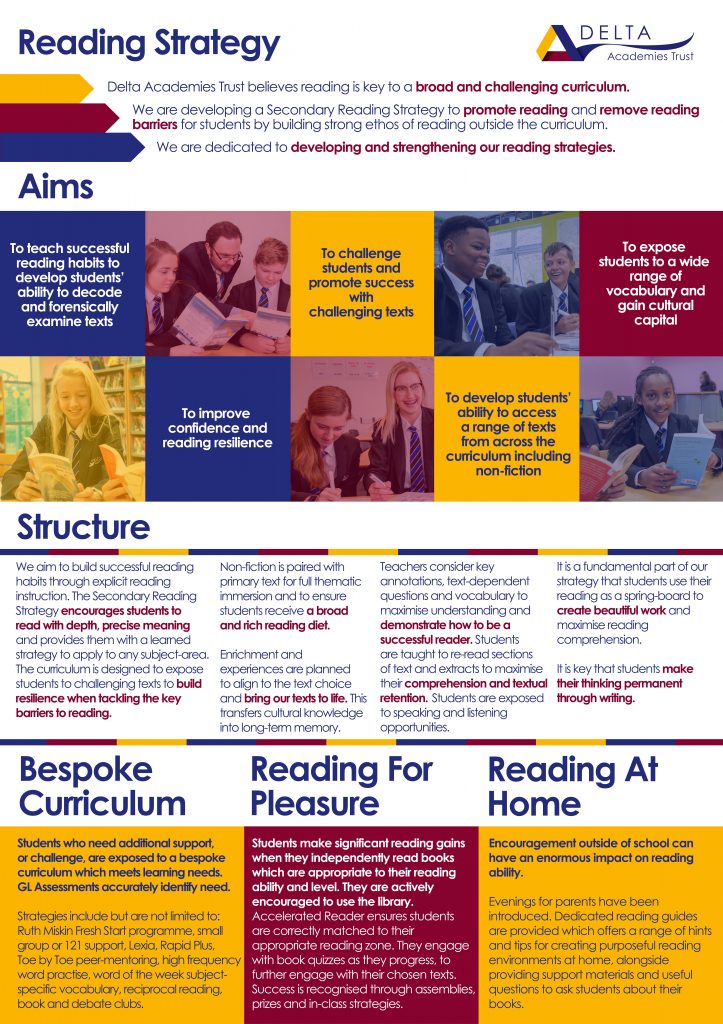Reading, Literacy and Oracy

Darton Academy is a school that loves to read. We believe that reading is the key to a broad and challenging curriculum. We are developing a Secondary Reading Strategy to promote reading and remove reading barriers for students by building a strong ethos outside of the curriculum. We are dedicated to developing reading strategies, and most of all, reading for pleasure; reading is of paramount importance and allows us to learn about other people, their history and their culture. There is no one size fits all approach to developing reading skills.
If your child reads for 20 minutes a day, they will be exposed to 1.8 million words per year.
Reading develops:
- vocabulary and writing
- memory and concentration
- creativity and imagination
To encourage this further, we have also introduced the exciting new reading for pleasure pathway: reading routes.
We make sure that the individual reading needs of every student are catered for through the following approach:

Structure
We aim to build successful reading habits through explicit teaching instruction. Nonfiction is paired with a primary text for full thematic immersion and to ensure students receive a broad and enriching reading diet. Enrichment and experiences are planned to align to the text choice and bring our texts to life. Students are taught to re-read sections of text and extracts to maximise their comprehension and textual retention
Bespoke Curriculum
When students enter Darton Academy, they complete a New Group Reading Test (NGRT), a standardised reading test consisting of multiple-choice and sentence-completion questions. This test gives us a Reading Age (RA) for each student. This is given in years and months, so a RA of 11.5 means that a student is reading at the equivalent of a child of 11 years and 5 months. To read more about the New Group Reading Test, please visit the GL website. From this data, we arrange bespoke intervention for our students based on their needs. This includes Ruth Miskin-Fresh Start, Reading Plus, Lexia Software Package and Accelerated Reader.
Ruth Miskin Fresh Start – Secondary
We invest in the Ruth Miskin Fresh Start phonics programme to ensure that we can deliver high frequency, high quality phonics teaching to students identified with this specific reading need at Darton. The programme is delivered by specialist, enthusiastic reading tutors who work with individuals or small groups to systematically teach the 44 phonic sounds they need to be able to read confidently and competently. Alongside the fundamentals of phonics, students are also exposed to thoughtfully graded, age-appropriate stories and non-fiction texts. These modules each come with nine reading activities and nine writing activities which develop our pupils’ comprehension ability.
Reading Plus
Reading Plus is an adaptive reading and literacy programme that gives individualised instruction and practice to our students to keep driving their reading progress forwards. We utilise the hybrid approach to this intervention strategy to give students the opportunity to learn online and at home, whilst they also benefit from teacher support during timetabled slots with one of our trained reading tutors.
Lexia Reading Programme
A small number of students enter the school with a lower reading age. For students with a Reading Age below 9, progress is tracked via computer software in order to provide specific measures and support that will allow them to make significant improvement. These students are given targeted intervention in Year 7 and 8 to improve their reading age.
Lexia Learning is a phonics-led IPad/PC based program which enables students to master essential reading skills. Students below reading age 9.9 (and therefore are unable to access the curriculum) use the Lexia programme and this allows us to work with them, track progress, and deliver any required interventions. Student progress is ‘live’- teachers and staff can log on and immediately see how a student in their group is doing. They can also log on at home and complete additional tasks to improve their reading ages even more!
Reading for Writing
Writing is among the most important thinking work that students can do. It’s also among the most challenging tasks for students, and one of the hardest to teach. We think all lessons should make sure that students learn to write as a way to develop and refine their understanding of text. Our curriculum asks students to write—constantly—in three different ways:
Developmental writing consists of exercises, embedded in the content of the reading, that seek to develop students’ syntactic control by focusing on craft at the sentence level.
Formative writing consists of exercises that let students use writing as a tool to develop and expand their thinking—to “think in writing.”
Summative writing asks students to form and develop paragraphs that explain and provide evidence for a more developed argument about the text
Reading their own books
If students are going to love reading, they will need to learn to find books that they love and to read them on their own. For this reason, students read books that they have chosen for themselves on at least one morning a week. Keen readers wishing to stretch themselves are encouraged to read books from the Reading Challenge list and take part in Stretch and Challenge reading where we read texts such as Jekyll and Hyde and Wuthering Heights.
“If you don’t like to read, you haven’t found the right book.” – J.K. Rowling

